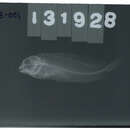Diagnostic Description
(
anglais
)
fourni par Fishbase
Species distinguished by: caudal fin with 3 or 4 dark bands on translucent background; segmented caudal-fin soft rays usually 13; segmented anal-fin rays usually 16 (west coast of Florida); pelvic fins with 1 spine and 3 soft rays; dorsal fin not separated into 2 portions by deep notch; dorsal-fin spines usually 12, the last easy to see; total dorsal-fin elements 25 to 30; pectoral-fin soft rays usually 13 or 14; no teeth on vomer; an enlarged canine tooth present posteriorly on both sides of 1 or both jaws (sometimes absent on 1 side); gill openings not continuous, each restricted to side of head, extending ventrally to about midlevel of pectoral-fin base or further; cirri present only on eyes; ventral edge of upper lip smooth; lateral line never consisting of 2 disconnected, overlapping portions. Common amongst Blenniids: small, slender fishes, largest species to about 13 cm SL, most under 7.5 cm SL. Eyes high on sides of head; mouth ventral, upper jaw not protractile. A single row of incisor-like teeth in each jaw and often an enlarged canine-like tooth posteriorly on each side of lower jaw and sometimes upper jaw; no teeth on palatines. Dorsal and anal fins long, their spines usually flexible; dorsal fin with fewer spines than segmented (soft) rays; 2 spines in anal fin, scarcely differentiated from the segmented rays, the first not visible in females, both often supporting fleshy, bulbous, rugose swellings at their tips in males; pelvic fins inserted anterior to base of pectoral fins, with 1 spine (not visible) and segmented rays; all segmented fin rays, except those of caudal fin, unbranched (simple), caudal-fin rays of adults branched. All species lack scales (Ref.52855).
- licence
- cc-by-nc
- droit d’auteur
- FishBase
Life Cycle
(
anglais
)
fourni par Fishbase
Oviparous, distinct pairing (Ref. 205).
- licence
- cc-by-nc
- droit d’auteur
- FishBase
Morphology
(
anglais
)
fourni par Fishbase
Dorsal spines (total): 12; Analspines: 2; Analsoft rays: 16
- licence
- cc-by-nc
- droit d’auteur
- FishBase
Biology
(
anglais
)
fourni par Fishbase
Oviparous. Eggs are demersal and adhesive (Ref. 205), and are attached to the substrate via a filamentous, adhesive pad or pedestal (Ref. 94114). Larvae are planktonic, often found in shallow, coastal waters (Ref. 94114).
- licence
- cc-by-nc
- droit d’auteur
- FishBase
- Recorder
- Cristina V. Garilao
Hypleurochilus caudovittatus: Brief Summary
(
anglais
)
fourni par wikipedia EN
Hypleurochilus caudovittatus, the zebratail blenny, is a species of combtooth blenny found in the western central Atlantic ocean, in the Gulf of Mexico off the western coast of Florida.
- licence
- cc-by-sa-3.0
- droit d’auteur
- Wikipedia authors and editors

